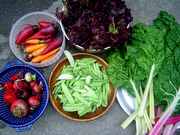

|
| Vegetable Varieties for Gardeners is a citizen science program
|
|
|
|
'Earliana' Tomatoes |
| |
| Sub-Category: |
Standard
Main-Season
Heirloom
|
| |
|
| Sub-Category 2: |
| | Description: |
Main-season, standard heirloom. Smaller (30- to 36-inch), indeterminate plants bear clusters of 4- to 5-ounce, red fruit. Similar to 'June Pink' but lacks rose-pink color and has shorter harvest season.
|
| Days To Maturity: |
85
|
| Seed Sources: |
Seed Savers Exchange - updated in 2014
|
| |
| Rating Summary |
| |
Overall: (2.5 Stars)
Taste: (2.0 Stars)
Yield: (3.5 Stars)
Ease/Reliability: (3.5 Stars) |
| |
| Reviews |
| |
Login to share your Review of Earliana.
Number of Reviews: 2
KEY: O=Overall Rating, T=Taste, Y=Yield, E=Ease
Reviewed on 08/13/2009 by
rwkrieger
- An intermediate gardener
|
 Overall Overall
 Taste Taste
 Yield Yield
 Ease Ease
|
Prince William, Virginia, United States
Frost Free Season: 163 - 183 days
Soil Texture: Clay
Garden Size: Medium - 400 square feet to 1,600 square feet
Sun Exposure: More than 8 hours per day
|
| I grew Earliana in a self-watering container this year and it worked pretty well for me in Northern VA. It ripened a few days later than Sophie’s Choice (also in container) and was a tad smaller but produced longer as the weather heated up. Taste and texture were good to me, not as good as later reds, but better than my experiences with Early Girl and about as good as some other early red slicers. |
| |
|
Reviewed on 09/17/2008 by
gandle
- An experienced gardener
|
 Overall Overall
 Taste Taste
 Yield Yield
 Ease Ease
|
Dawson, Nebraska, United States
Frost Free Season: 143 - 163 days
Soil Texture: Loam
Garden Size: Medium - 400 square feet to 1,600 square feet
Sun Exposure: More than 8 hours per day
|
| Not a good slicer. Taste not up to most other tomatoes. Grandmother liked this one for canning in the 20's, the size of the fruit was good for that. |
| |
|
|
|
|
Vegetable Varieties for Gardeners is a citizen science program, © 2004-2024, All Rights Reserved
Cornell Garden Based Learning, Cornell University College of Agriculture & Life Sciences, Horticulture Section
|






 VVfG home
VVfG home
 Overall
Overall Yield
Yield Taste
Taste
